Page Content
Research: What is it good for?
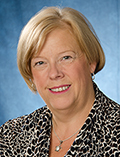
Shelley Magnusson, Executive Staff Officer
Are you familiar with the 1969 Edwin Starr song that asked “War, what is it good for?” and answered with a resounding “Absolutely nothing!”? Well, if we ask the same question about education research, the Alberta Teachers’ Association’s answer would be, “Absolutely everything.”
The Association is recognized worldwide for its research on education issues. The ATA has been unofficially active in the field of research since its inception in 1918, and in 1960 the Association published its first research monograph Teacher Aides, written by Kathleen Kennedy. Today, the Association is involved in numerous research projects in Alberta, Canada and the world.
The Association’s prestige in the world of education research is growing, so much so that internationally recognized researchers and research facilities are actively seeking out opportunities to collaborate with the Association. One recent example of this is the partnership between the Association and the Harvard School of Public Health in a comprehensive study on the long-term health effects of digital technologies on our young people.
Another example of the Association’s growing international profile is the partnership, which began in 2010, with Alberta’s minister of education and the Finnish Ministry of Education and Culture in Helsinki (FINAL). This partnership pursued an altogether different strategy in educational change and reform that is bottom-up and side-to-side rather than top-down, and involved not just policy makers and researchers, but teachers and students from several schools in Alberta and Finland. The residual effects are being felt in both jurisdictions.
Although that partnership has officially wrapped up and the FINAL project is now ending, a new and exciting partnership is emerging with Norway.
Last year the Association struck the Blue Ribbon Panel on Inclusive Education in Alberta Schools, whose report and recommendations have been well received by both educators in the field and policy-makers within Alberta Education.
Whether the Association is studying the workload of teachers in a specific local such as Calgary or Rocky View, or looking at a more global perspective — as in the soon-to-be-released Teaching and Learning Conditions in Alberta: A Global Perspective, which drew on data from the Organization for Economic Co-operation and Development — the Association’s high standards and rigour are being maintained.
Through all the research endeavours the Association undertakes, the main driving force is always the quest to answer the age-old question: How will this research help us to improve the working lives of our teachers and learning conditions of our students? And the quest continues.
The Alberta paradox of international rankings
 J-C Couture, Associate Co-ordinator — Research
J-C Couture, Associate Co-ordinator — Research
While the media focuses on Alberta’s high standing on international tests — among English speaking jurisdictions, we are one of the top performers in Programme for International Student Assessment (PISA) testing — few pundits focus on the underside of other rankings by the Organisation for Economic Co-operation and Development (OECD). Specifically, often overlooked is the Teaching and Learning International Study (TALIS), which measures indicators of teaching and learning environments (i.e. class size and composition, access to professional development, school and community characteristics).
What is remarkable is that the Association’s research illustrates what TALIS and a number of other international studies have confirmed: that the teaching and learning conditions of Alberta teachers are simply unsustainable. Except for their colleagues in Japan, no other teachers among the OECD countries put in more hours per week (56 hours) than Alberta teachers. Furthermore, Alberta teachers work in classrooms that have two to three times the level of complexity compared to the benchmarks used by the OECD. The research increasingly highlights the Alberta paradox: we simply cannot maintain our leading position as a high flyer while ignoring the increasing expectations of the teaching force.
Dr. J-C Couture is an executive staff officer with the Alberta Teachers’ Association.
Teachers on the margins
 Phil McRae, Executive Staff Officer
Phil McRae, Executive Staff Officer
Recent research on learning and technology is finding that in regards to digital reporting tools in Alberta (e.g., PowerSchool and Teacher Logic) teachers have been kept on the periphery of decision making. They have had very little or no input at all in choosing or implementing the tools by which they are to report their students’ learning (93 per cent have had little to no input).
Given the growing impacts on workload for teachers, and within a context of declining professional development and technological supports, teachers must be at the centre of all of the key decisions around educational technology, not pushed to the margins.
Dr. Phil McRae’s research is focused on curriculum studies and emerging technologies.
Report of the Blue Ribbon Panel on Inclusive Education in Alberta Schools
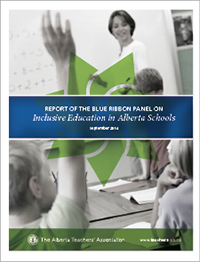 Key Findings
Key Findings
The recommendations include the following:
- Establish a provincial stakeholder advisory committee and a school-jurisdiction-level inclusive education advisory committee to work toward developing and implementing a plan
- Monitor inclusive education funding provided and determine the actual costs of supporting all students effectively
- Conduct regular research in Alberta classrooms to determine the effectiveness of inclusion and to advance this field of study
- Ensure that province-wide guidelines for average class sizes—which should take classroom complexity into account—are achieved
- Enable teachers to engage in professional development activities and to meet in collaborative teams to learn and share strategies to support inclusive practices
- Provide opportunities for parents to learn and engage in dialogue about inclusion
A research update on the Blue Ribbon Panel work is due this spring.
Delivery Matters: Cyber Charter Schools and K–12 Education in Alberta
An ATA-contracted study by Parkland Institute
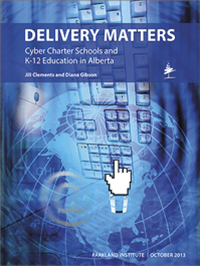 Key Findings
Key Findings
Cyber charter schools—which receive money from the state at a per-child rate and, in turn, pay management firms (such as K–12 Inc) to run the day-to-day operations of delivering education—are expanding:
- Student enrolment in cyber charter schools in the United States jumped nearly 40 per cent in 2009/10.
- Revenues from the K–12 online learning industry are expected to grow by 43 per cent between 2010 and 2015, at which point revenues will reach $24.4 billion.
Alberta Voices: Teachers’ Aspirations for the Future of Teaching
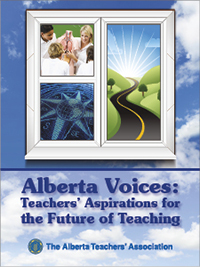 Key Findings
Key Findings
Ways in which teachers’ aspirations for teaching can best be served include:
- supporting teachers’ work through positive leadership practices,
- nurturing a systemic culture that supports teachers’ strengths and enhances professional capital and
- reducing or reassigning non-teaching tasks so that teachers can focus on knowing and responding to their students.
A Great School for All—Transforming Education in Alberta
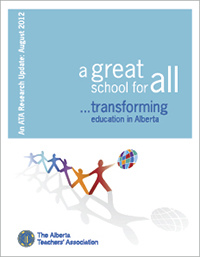 12 Dimensions For Transforming Education in Alberta
12 Dimensions For Transforming Education in Alberta
- Assessing and reporting
student learning
- Curriculum development
and implementation
- Digital technologies and learning
- Inclusive education
- Optimal conditions of practice
- Differentiation for learning
- Professional development and autonomy
- Public assurance
- School leadership
- Teacher leadership
- Early learning
- Governance and vibrant communities
The Finland–Alberta (FINAL) International Partnership
 Key Findings
Key Findings
FINAL is driven by the principle that transformation is best enabled by educational systems that support local innovation. For the FINAL partnership, thinking ahead, leading across and delivering within involve focus on ‘big-picture’ policy issues aimed at bringing about structural reforms and long-term strategic shifts in the two jurisdictions. For example, the Finnish government is currently overhauling its basic education sector to deal with the growing challenges of globalization and economic instability. This work includes curriculum renewal and rethinking high school pathways to success—two areas of interest in Alberta.
The 2011/12 National Study on Balancing Work, Life and Caregiving in Canada: The Situation for Alberta Teachers
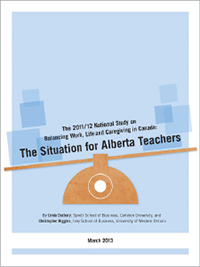 Key Findings
Key Findings
The analysis indicates that teachers face role overload, resulting in lack of work–life balance, as the following illustrates:
Teachers averaged about 60 hours/week of work.
- Seventy-one per cent of the sample indicated being overloaded by their work role.
- Over 80 per cent of the ATA sample reported high levels of total overload.
Role overload leads to lower job satisfaction and commitment to organization, as well as higher absenteeism and perceived stress and/or depressed mood.
The Future of the Principalship in Canada: A National Study
A collaboration between the ATA and the Canadian Association of Principals
 Key Findings
Key Findings
Across Canada, school leaders share concerns and face similar issues. There are
regional particularities, but the top three concerns for Canadian principals are
- school role overload (reported as an area of concern by 43 per cent),
- policy problems related to social media (reported as an area of concern by 41 per cent) and
- meeting diverse student needs (reported as an area of concern by 36 per cent).
Digital Reporting and Digital Assessment Tools: Evaluating their Value and their Impact
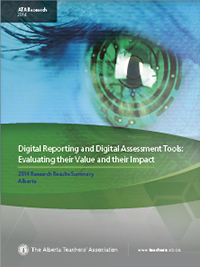 Key Findings
Key Findings
Participants report the following regarding online reporting and assessment tools:
- Sixty-three per cent suggest that these tools have not improved instruction and assessment for students.
- Sixty-six per cent indicate that these tools have increased or significantly increased workload for teachers.
- Ninety-three per cent report having little to no input in selecting or implementing these tools.
Teaching and Learning Conditions in Alberta: A Global Perspective
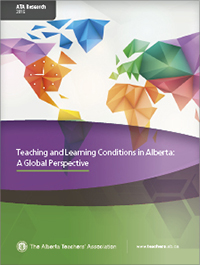 Key Findings
Key Findings
The report discusses the following themes that emerge from several of the studies:
- Five of the seven studies report the number of hours worked per week, on average, by Alberta teachers; the studies’ findings range from 48 to 60 hours of work per week.
- Alberta teachers work, on average, 10 hours more than the international average and with larger class sizes than many other Teaching and Learning International Study (TALIS) jurisdictions.
- Alberta reports a higher average of hours worked by teachers and a higher degree of diversity and complexity of student learning needs than, with the exception of Japan, all other TALIS jurisdictions.
- Alberta teachers seem satisfied with their jobs; however, overall well-being appears to be on the decline, with increasing workloads affecting work–life balance.
